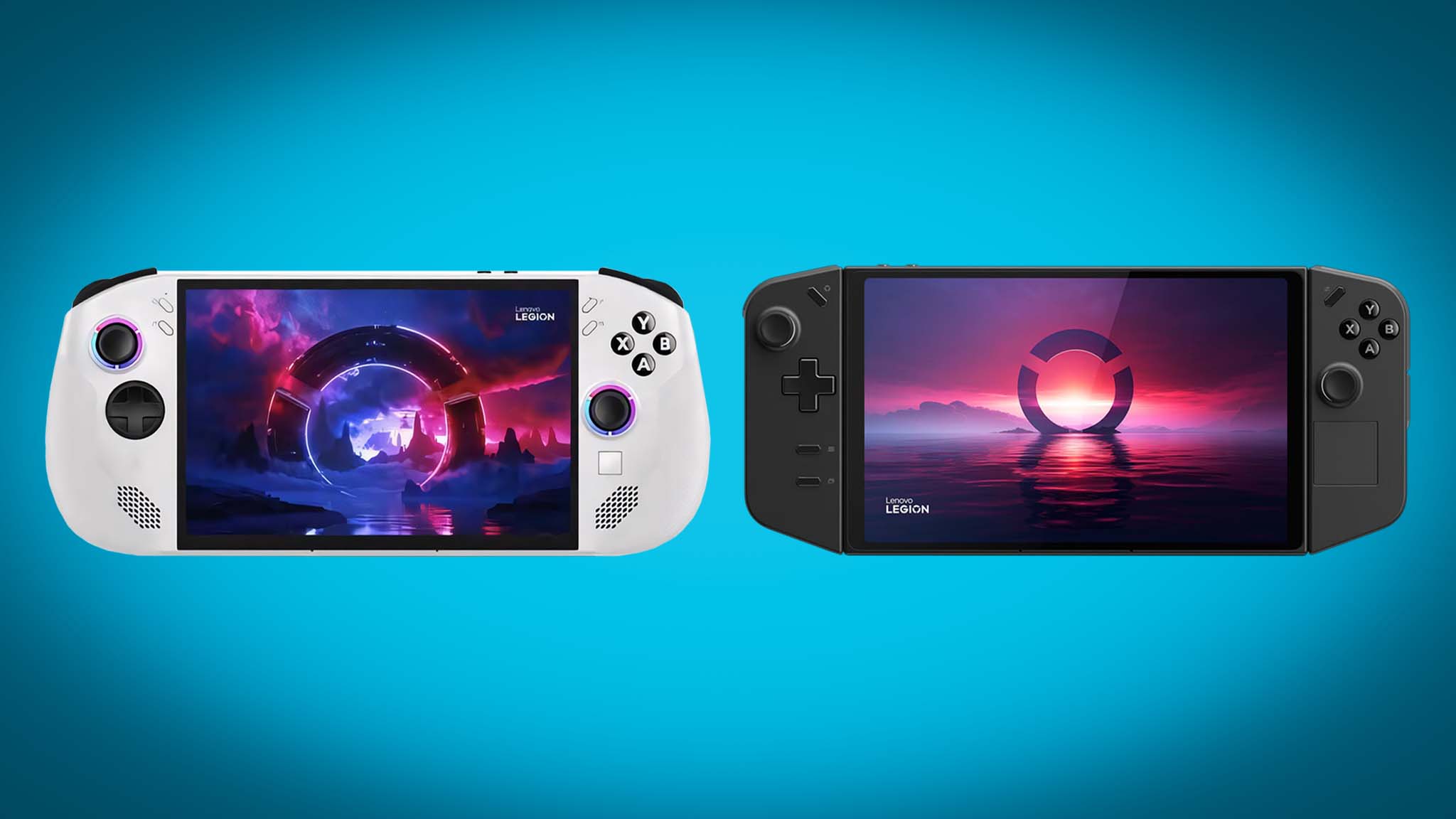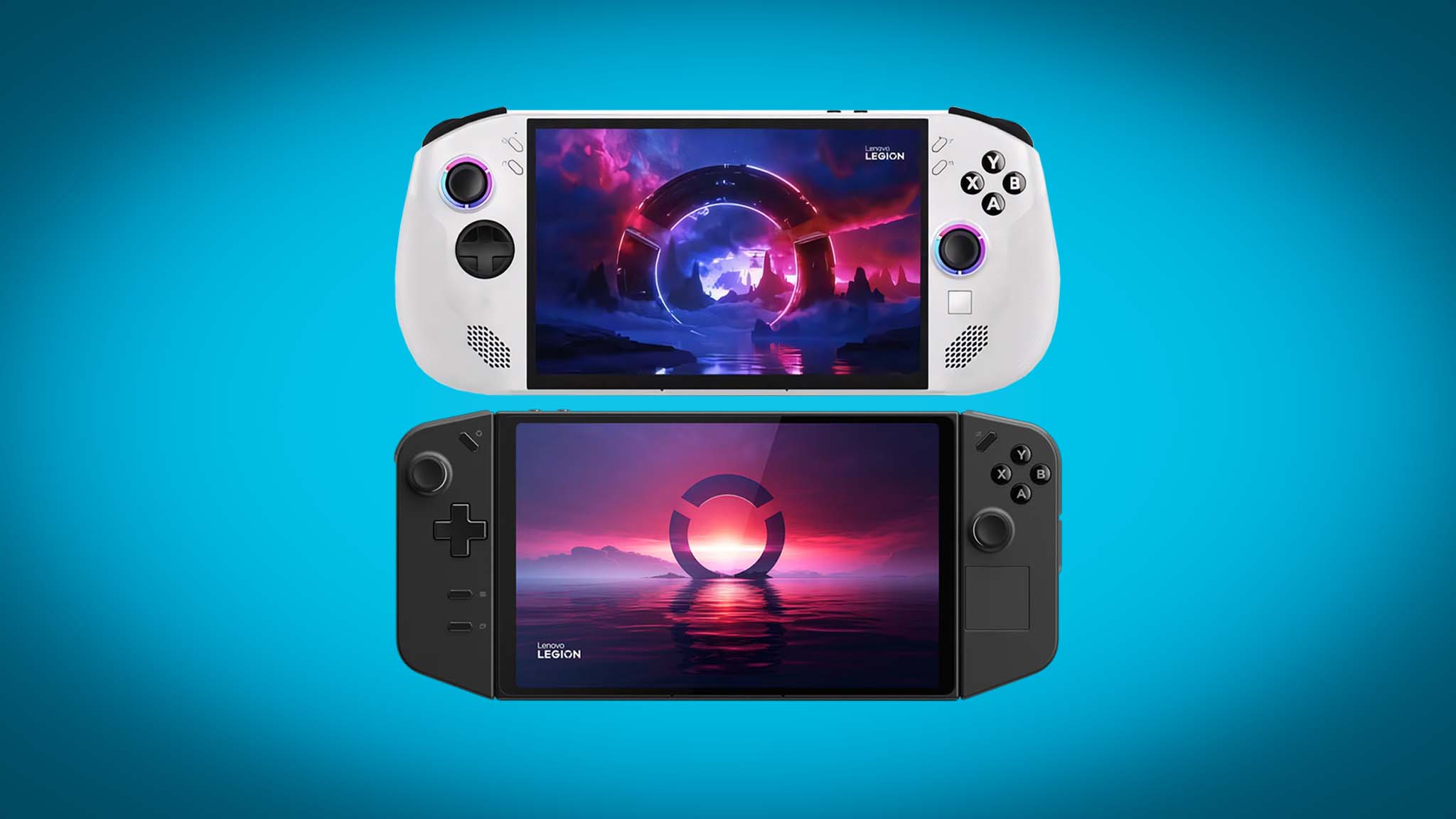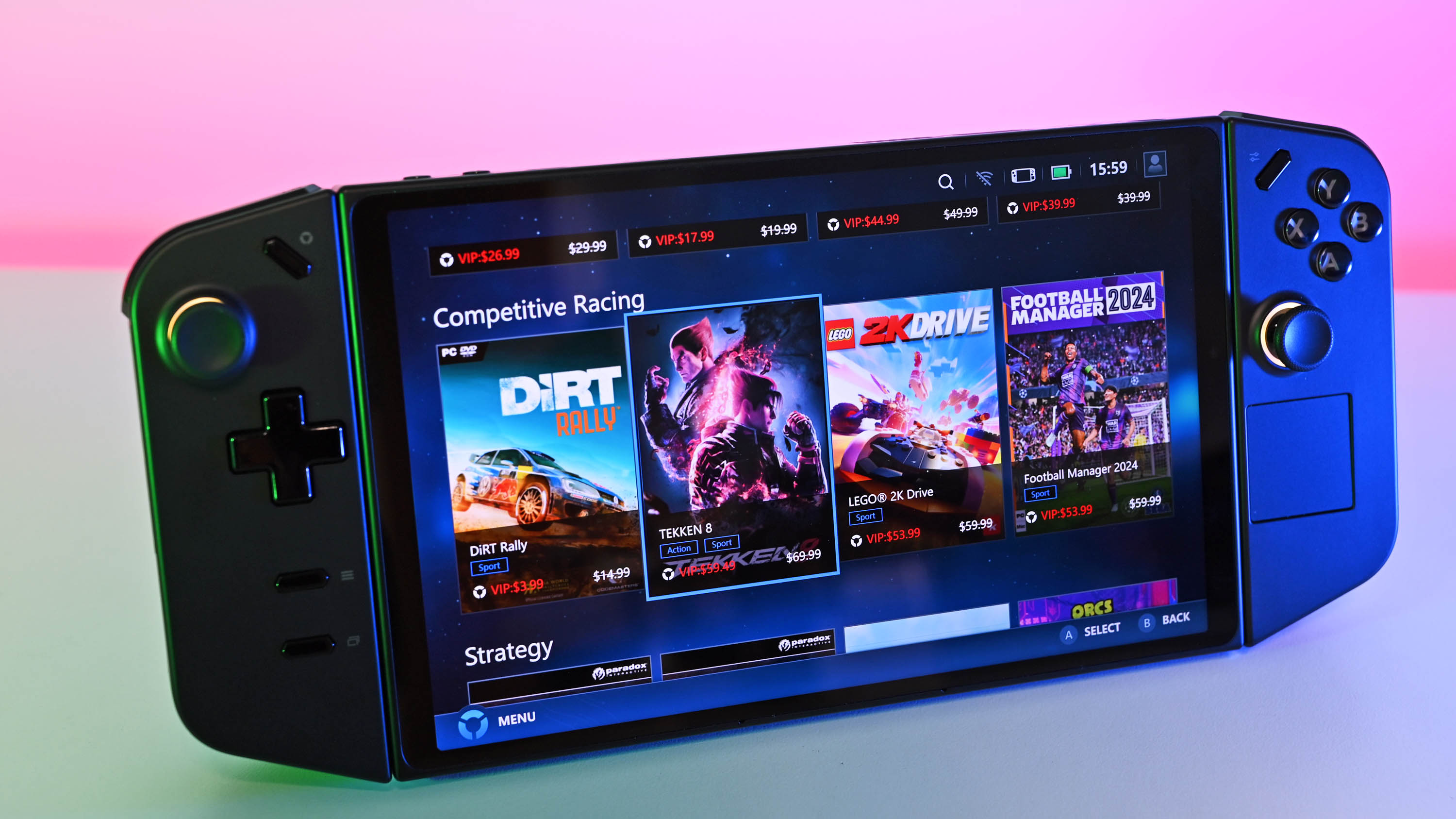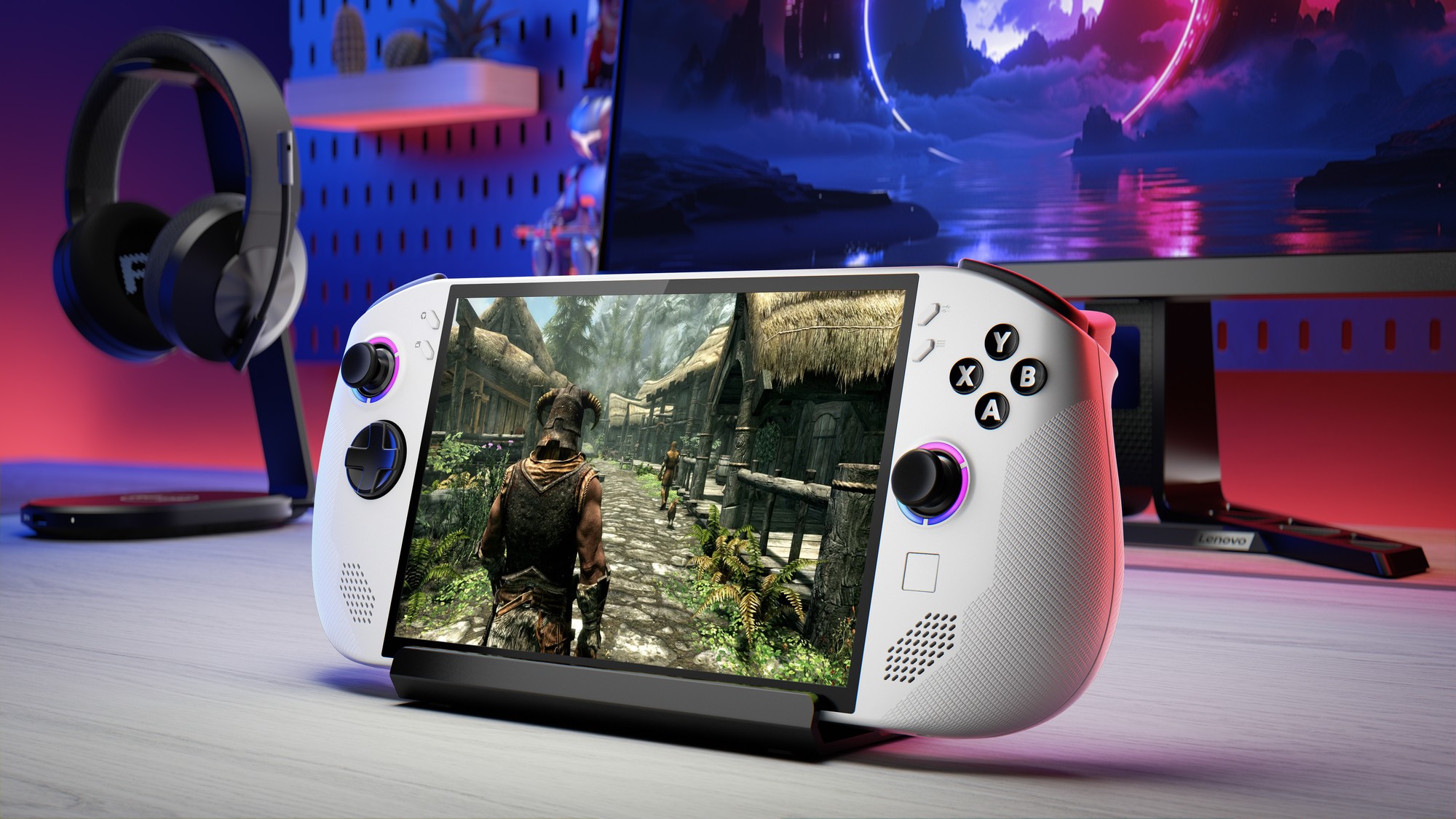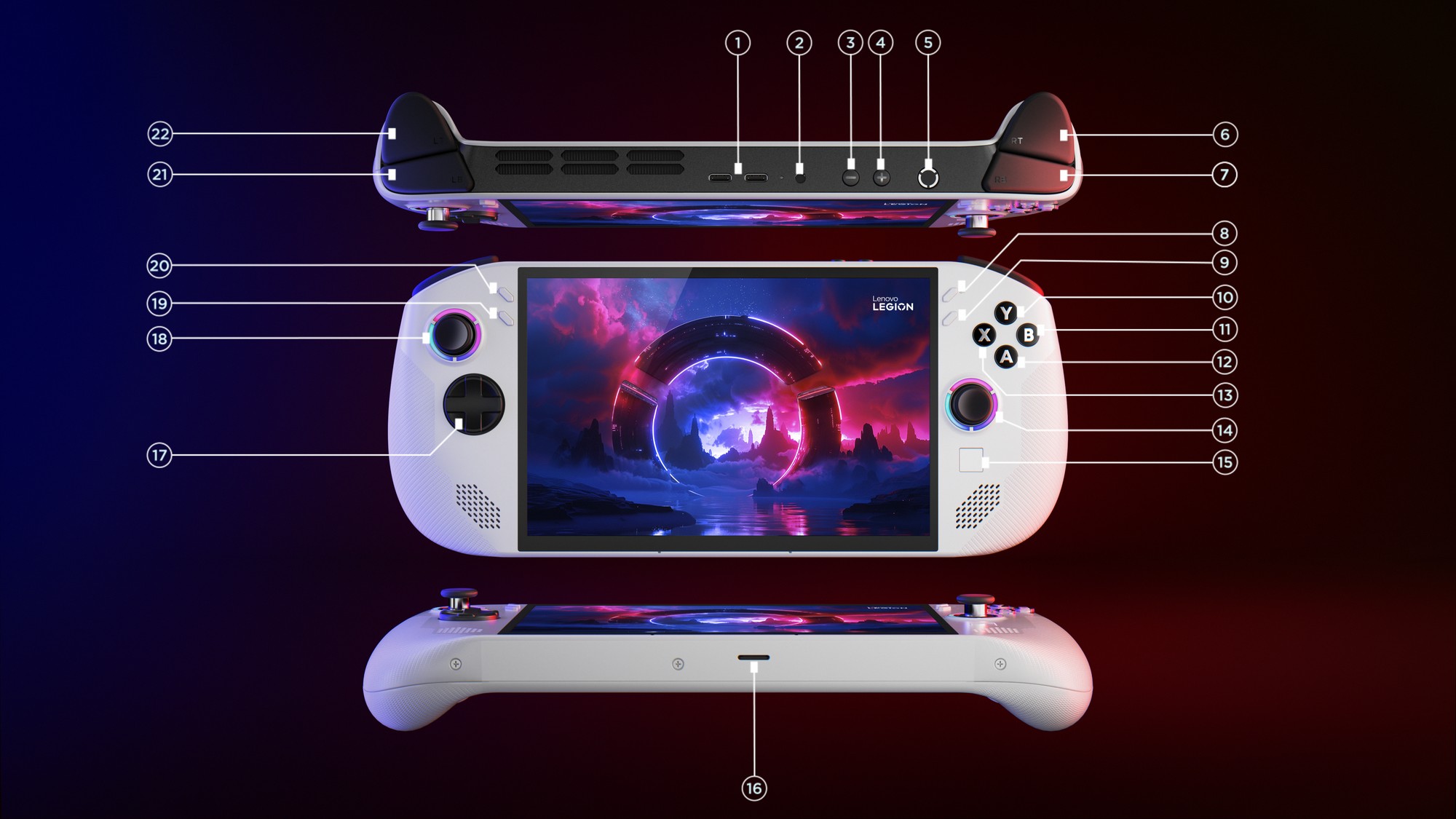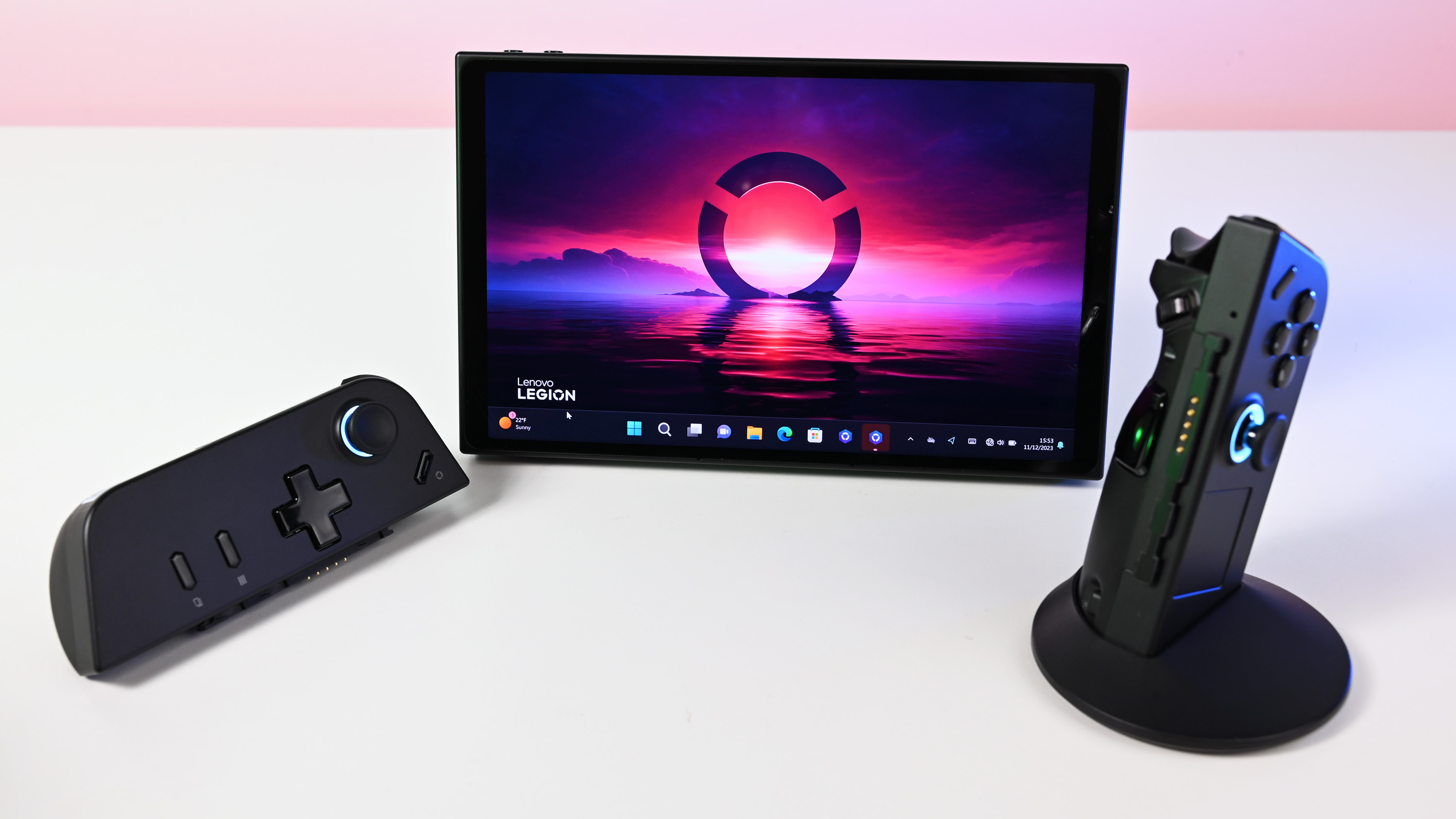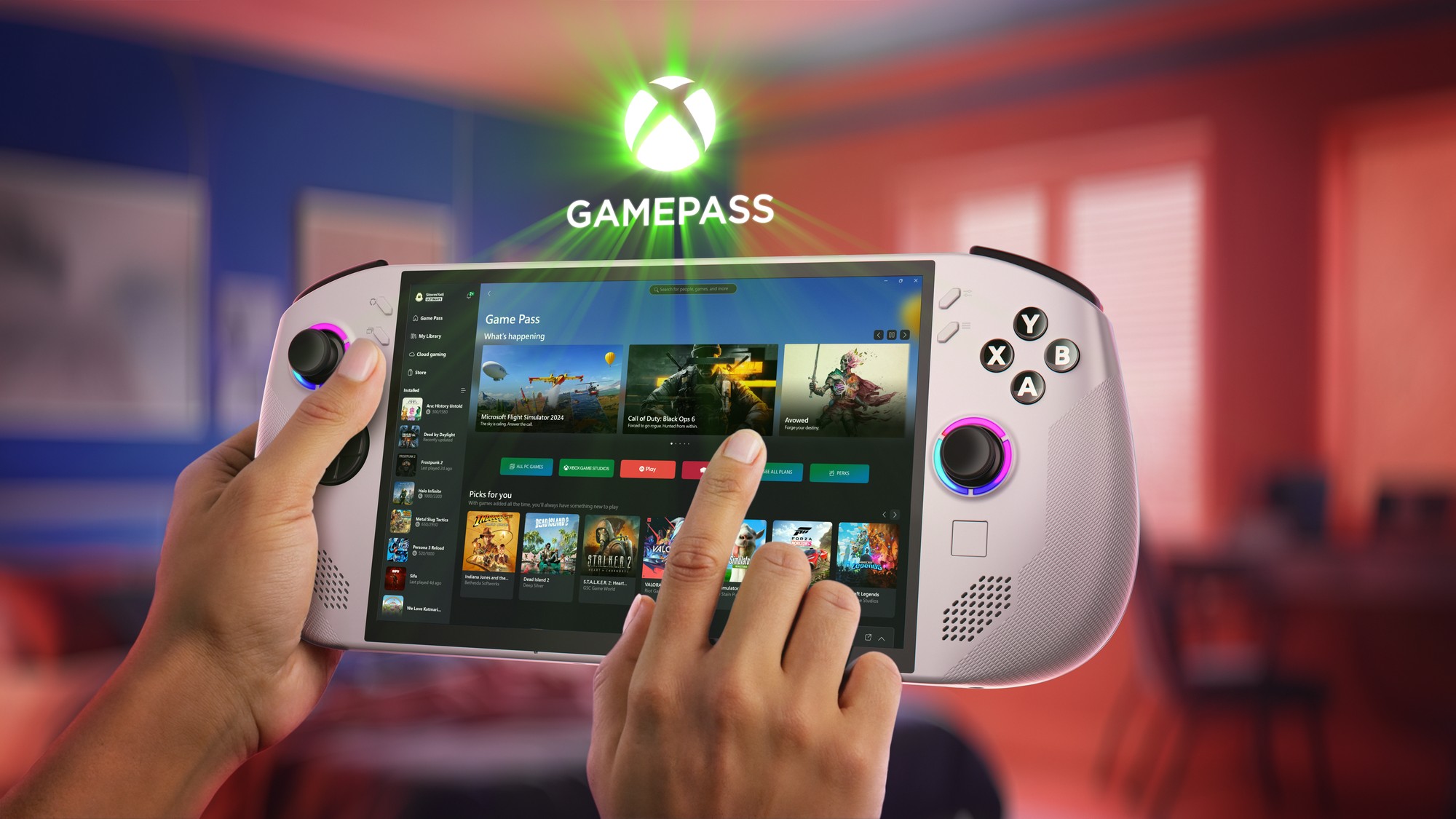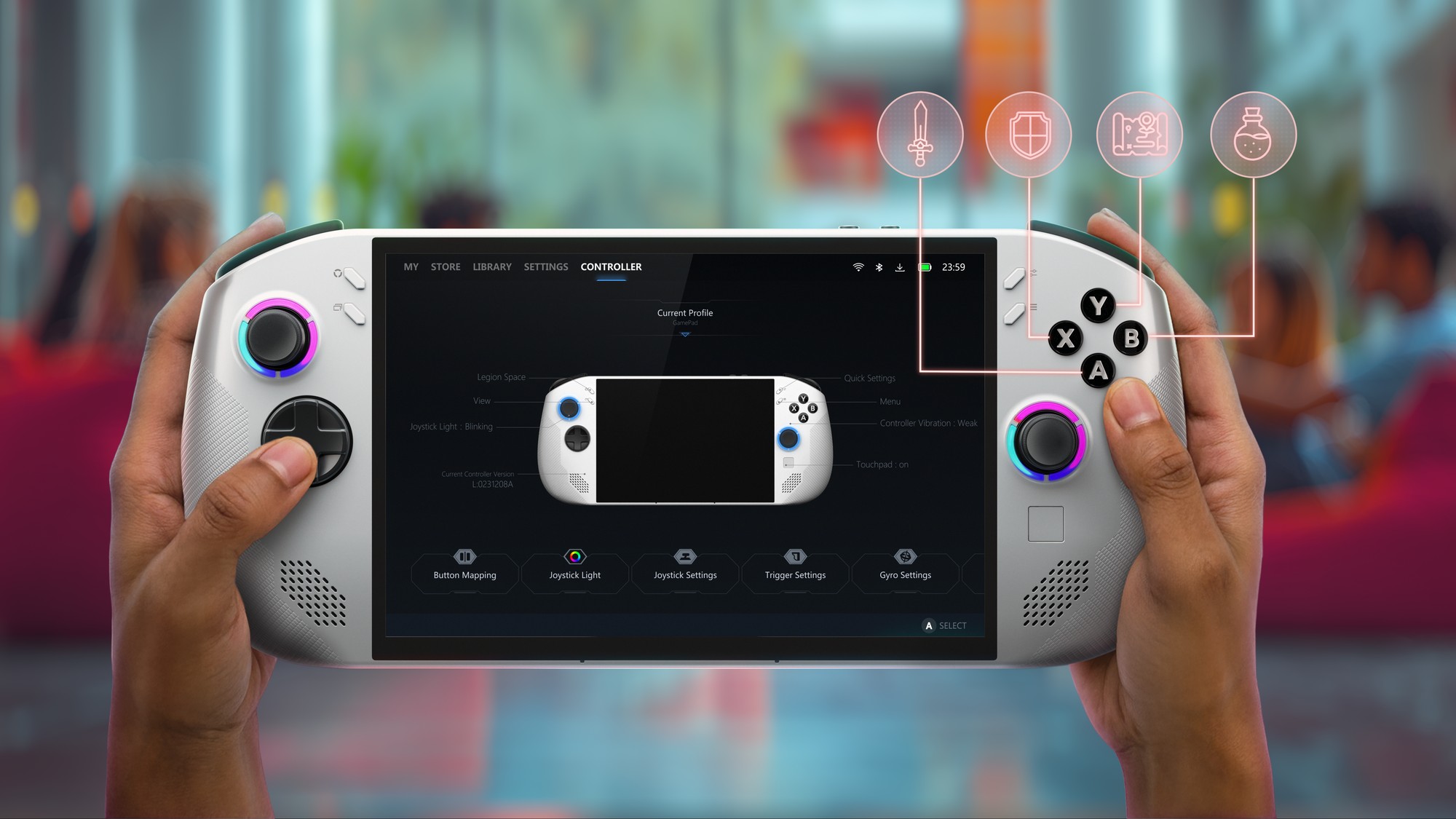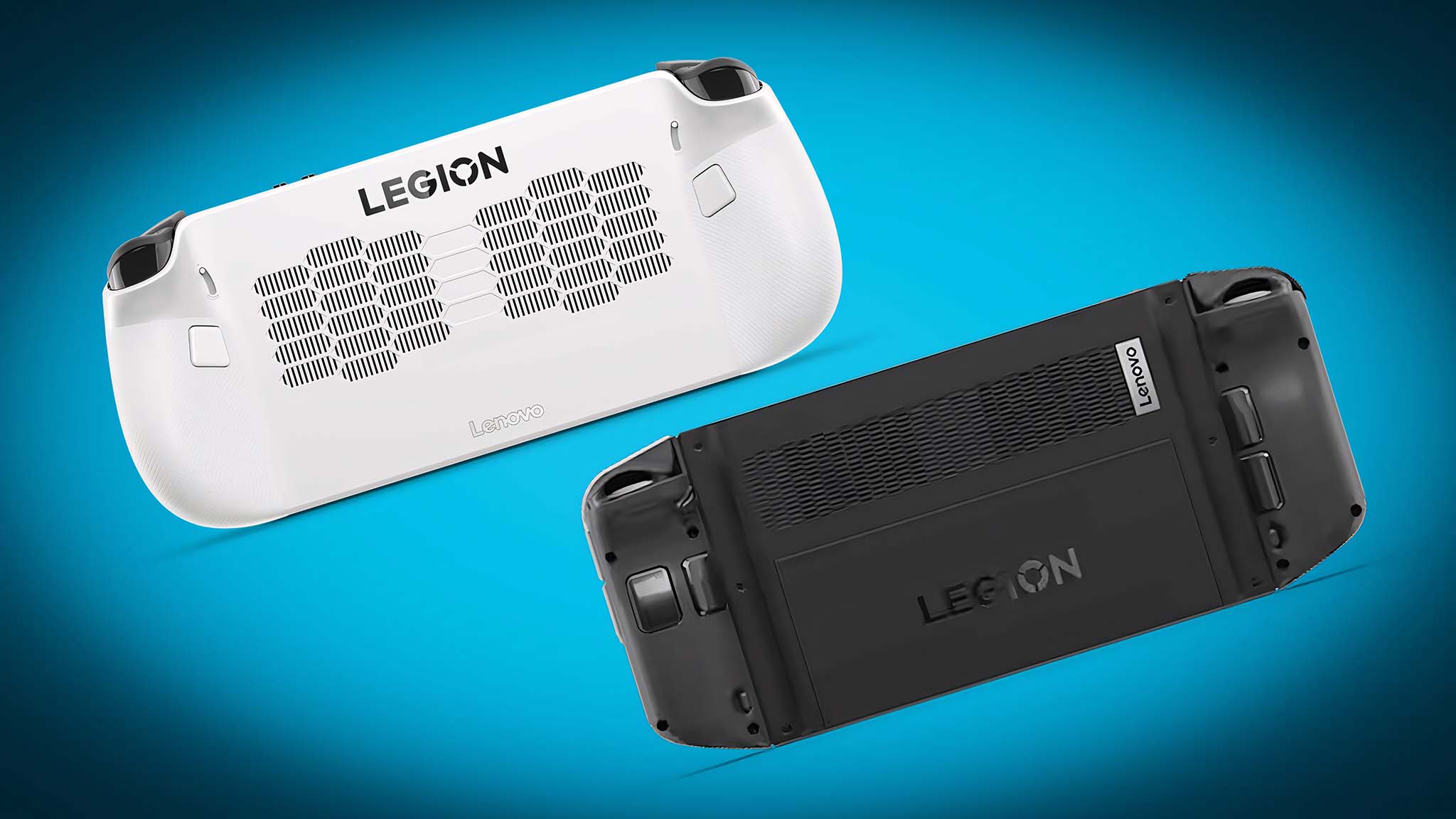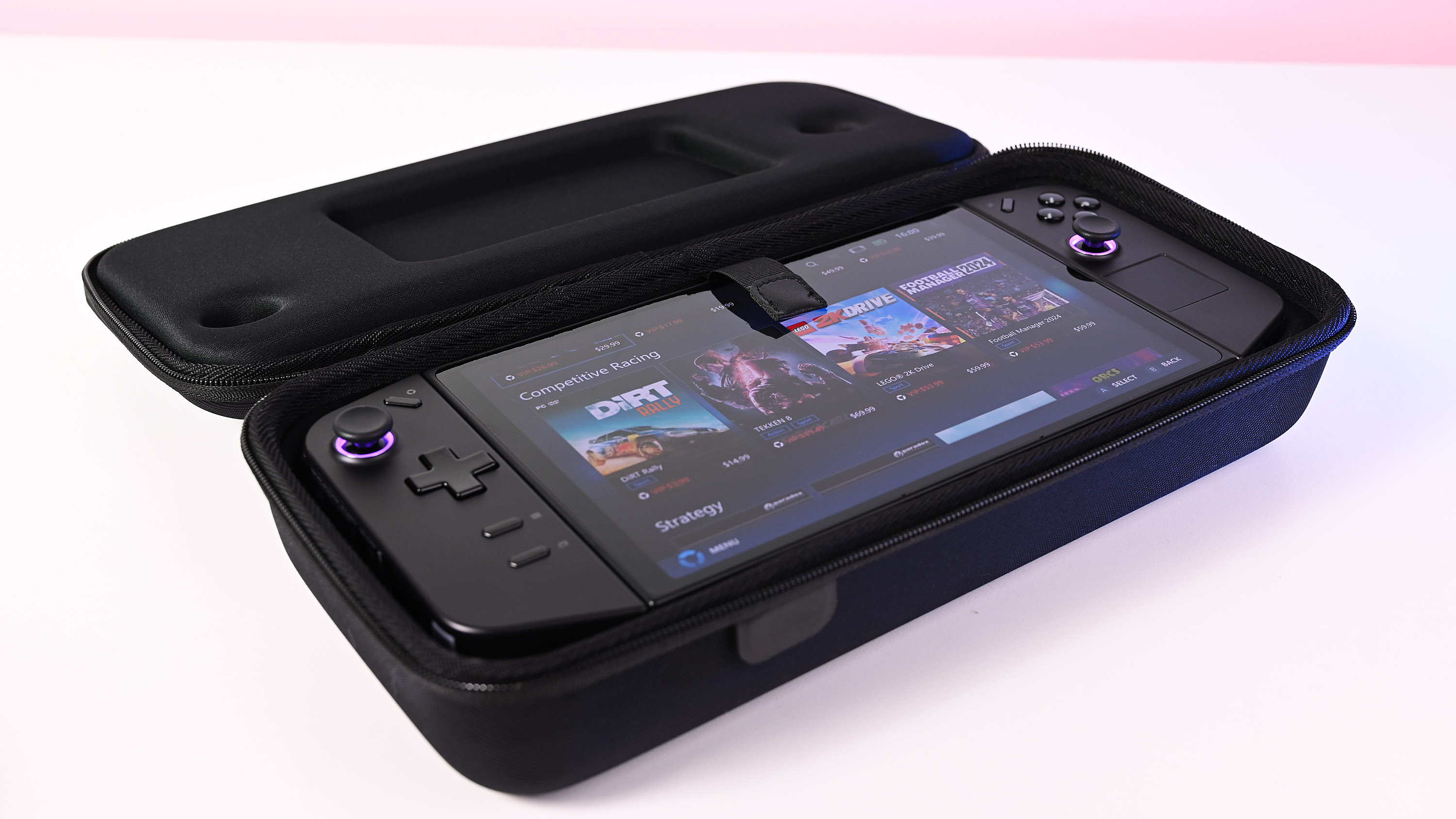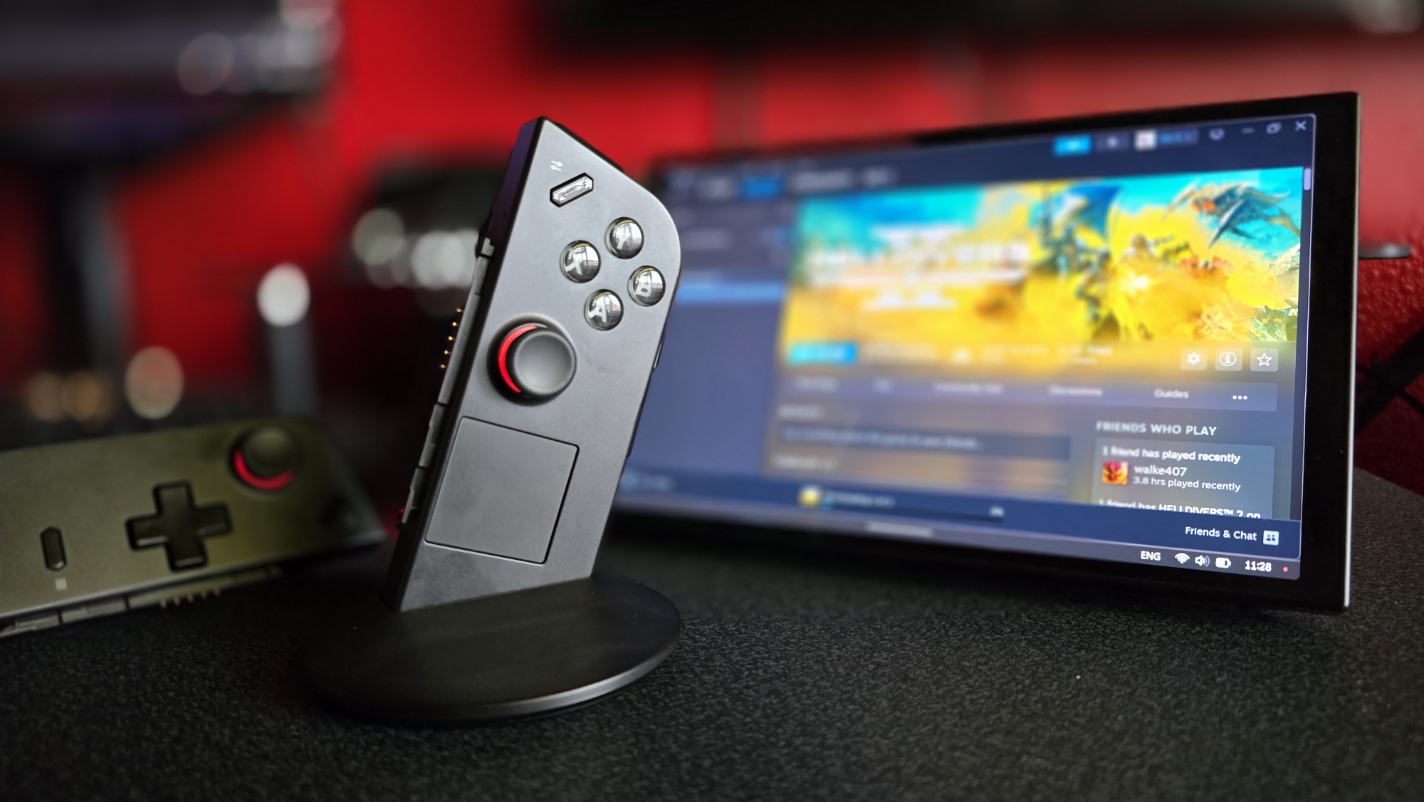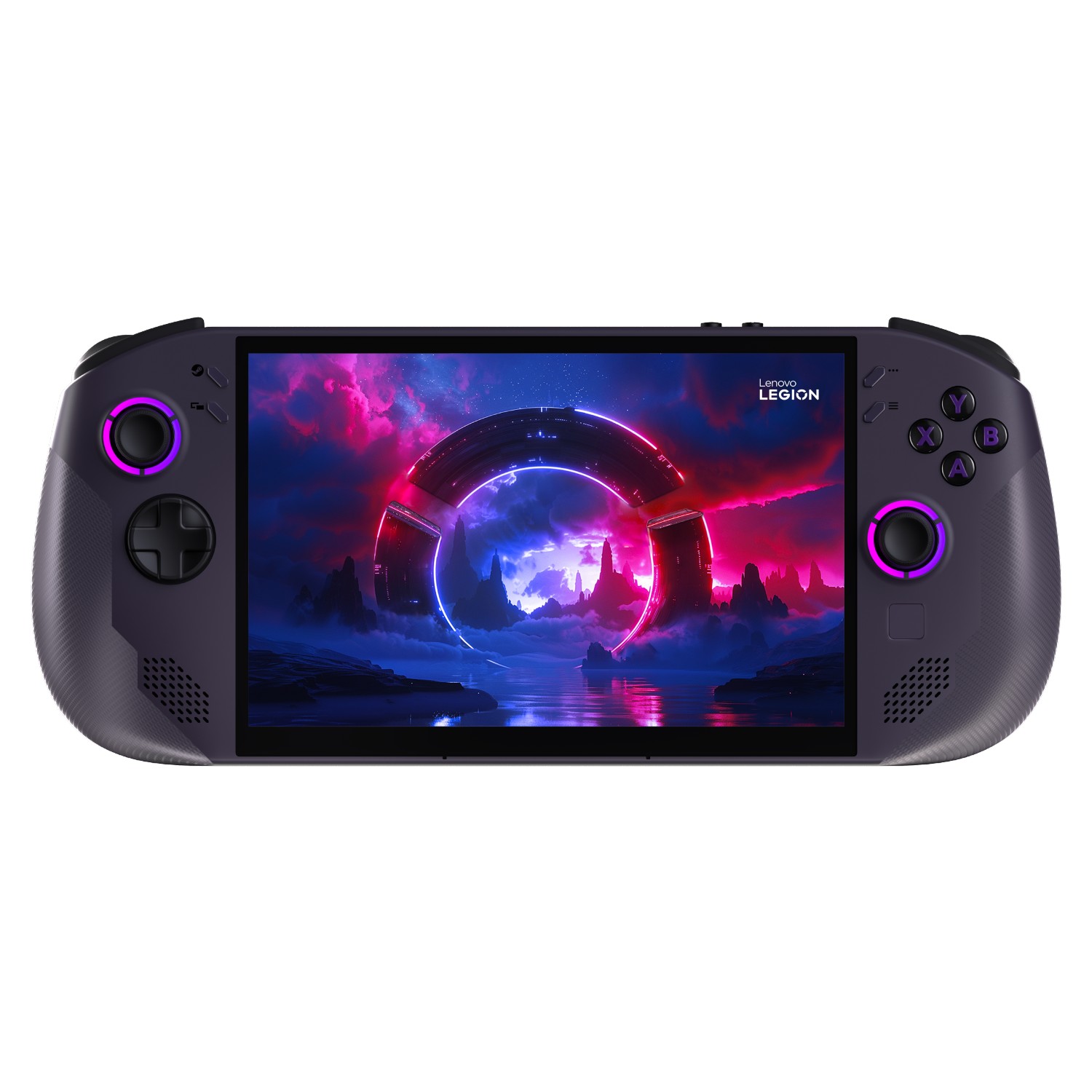Lenovo Legion Go S vs Legion Go: What's the difference?
The new Legion Go S has a Windows 11 model and a SteamOS model.

This newer handheld is slightly smaller than the original Legion Go and has a smaller 8-inch LCD touchscreen, too. Resolution has been lowered to a max of 1920 x 1200p, and the refresh rate is also reduced to 120Hz, but that's still plenty good for handheld play. You can get a SteamOS version or a Windows 11 version. Additionally, the handheld can have either an AMD Ryzen Z2 Go chip or a more powerful Z1 Extreme with up to 32GB RAM and up to 1TB SSD. Instead of simple USB-C ports, this handheld features two USB4 ports to handle your connection needs.
Pros
- Smaller and more compact design
- Has two Thunderbolt 4 ports
- There's a SteamOS version or Windows 11 version
- Excellent ergonomic shape and balance
Cons
- Controllers do not detach
- Lower resolution and refresh rate
- New Z2 Go chip is less powerful than Go's Z1 Extreme
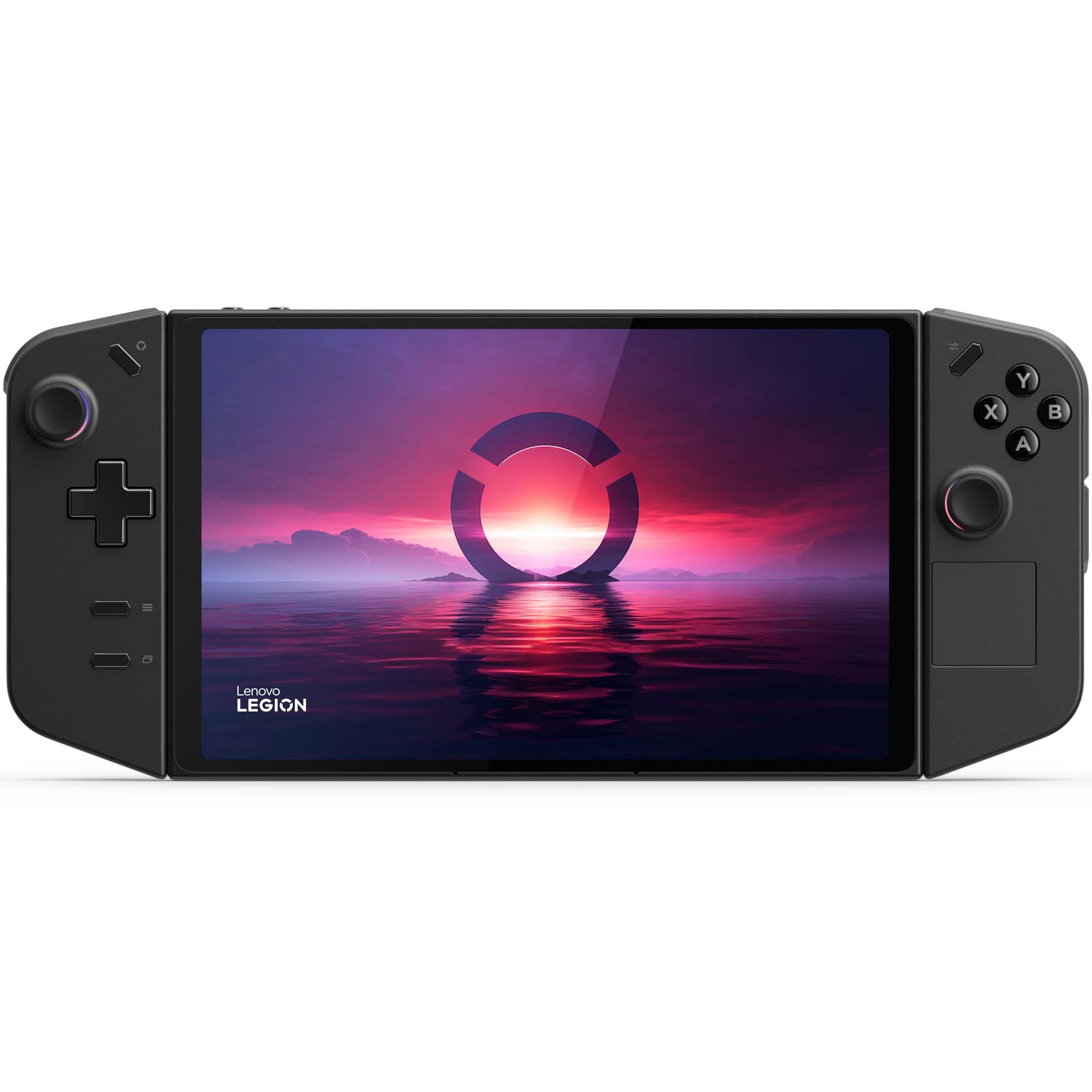
The original Legion Go features detachable controllers and a built-in kickstand for tabletop play. The 8.8-inch IPS touchscreen supports up to 2560 x 1600 resolution and a higher 144Hz refresh rate but without VRR support. It runs Windows 11 with an AMD Ryzen Z1 Extreme chip, RDNA graphics, 16GB RAM, and up to 1TB SSD. There is no SteamOS version. Additionally, there are two USB-C ports to facilitate simultaneous charging and accessory usage. However, one is on top while the other is on the bottom of the device.
Pros
- Has detachable controllers and a kickstand
- Higher refresh rate and resolution
- Larger 8.8-inch IPS touchscreen
Cons
- No SteamOS options
- Doesn't have USB4 ports
I personally conducted our own Lenovo Legion Go review here at Windows Central shortly after the handheld was released in 2023.
It is a fantastic device, but as with most first iterations, it has room to improve. Now, Lenovo has revealed a newer and slightly smaller model in the form of the Legion Go S.
My colleague, Zachary Boddy, did our Legion Go S review. While not a next-gen device like the upcoming Legion Go 2; it has some improvements over the original handheld as well as some downgrades.
It's important to note that there are two versions of the Legion Go S. One is officially labeled the Legion Go S (8" , 1) and runs Windows 11 while the second one is referred to as Legion Go S — Powered by SteamOS (8" , 1) and runs SteamOS. That's quite a mouthful, so I'll mostly just refer to these handhelds as either the Windows 11 or SteamOS version of the Legion Go S.
How do the Legion Go S and Go specs compare?
Let's dive in and discuss the differences between the original Legion Go and the new Legion Go S devices.
| Header Cell - Column 0 | Legion Go S | Legion Go |
|---|---|---|
Price |
| $699.99 | $749.99 |
Release date | Jan 2025 | May 25, 2025 (SteamOS) | Nov 1, 2023 |
OS | Windows 11 Home | SteamOS | Windows 11 Home |
Display | 8-inch WQXGA (1920 x 1200) 16:10 LCD touchscreen, 500 nits, 97% DCI-P3 | 8.8-inch QHD (2560 x 1600) 16:10 IPS touchscreen, 500nits, 97% DCI-P3 |
Refresh rate / VRR | 120Hz / Yes | 144Hz / No |
Processor | AMD Ryzen Z2 Go, AMD Ryzen Z1 Extreme | AMD Ryzen Z1 Extreme |
Graphics | Integrated AMD Radeon 700M Series | Unknown | RDNA Graphics |
Memory | Up to 32GB 6400Mhz LPDDR5X | 16GB 7500Mhz LPDDR5X |
Storage | Up to 1TB PCIe SSD (Gen 4) | 512GB | 1TB SSD |
Connectivity | Wi-Fi 6E and Bluetooth 5.3 | Wi-Fi 6E and Bluetooth 5.3 |
Ports | 2x USB4, 1x microSD card reader, 1x audio jack | 2x USB-C 4.0, 1x microSD card reader, 1x audio jack |
Touchpad | Yes (one) | Yes (one) |
Detachable controllers | No | Yes |
Color | White or Nebula Violet (dark purple) | Black |
Dimensions (controllers attached) | 299 x 127.55 x 22.6mm (11.77 x 5.02 x 0.88in) | 299 x 131 x 41mm (11.8 x 5.15 x 1.61in) |
Weight | 740g (1.63 lbs) | 854g (1.88 lbs) |
Battery | 55.5 Whr | 49.2 Whr |
*The prices of the Lenovo Legion Go S have gone up over the last few weeks, likely due to the US-China tariff situation.
As shown in the above table, there are some significant differences between the original Legion Go and the Legion Go S.
All the latest news, reviews, and guides for Windows and Xbox diehards.
Now that you've been able to see the specs, let's discuss what these differences mean for you as a potential handheld owner.
Which is better value: the Go S or Legion Go?
The original Legion Go has a starting price of $699.99 at Best Buy, but if you go with the higher SSD, it has a $749.99 MSRP.
Things get a bit tricky with the new Legion Go S.
When Lenovo originally revealed the Legion Go S in January 2025, the company listed the SteamOS, Z2 Go model's starting configuration at a $499.99 MSRP. However, the price has since gone up by $100 at retailers, likely due to the US-China tariff situation.
Meanwhile, the Windows Legion Go S has a starting price of $729.99, but can go as high as $899.99 if you get the Z1 Extreme configuration.
Price | Handheld |
$699.99 | Lenovo Legion Go (Z1 Extreme, 16GB, 512GB) |
$749.99 | Lenovo Legion Go (Z1 Extreme, 16GB. 1TB) |
| Lenovo Legion Go S (SteamOS, Z2 Go, 16GB, 512GB) |
$729.99 | Lenovo Legion Go S (Windows, Z2 Go, 32GB, 1TB) |
| Lenovo Legion Go S (SteamOS, Z1 Extreme, 32GB, 1TB) |
| Lenovo Legion Go S (Windows, Z1 Extreme, 32GB, 1TB) |
From our own testing, we know that the Z2 Go chip isn't nearly as powerful as the Z1 Extreme. This being the case, we recommend going with a Z1 Extreme configuration if you do buy a Legion Go S. It won't struggle nearly as much when playing certain games.
That said, the base $699.99 Legion Go Z1 Extreme is not only cheaper than the $829.99 Legion Go S Z1 Extreme model, but is a better value than the Legion Go S Z1 Extreme since it also offers detachable controllers and a built-in kickstand.
The tradeoff is that the original Legion Go has less RAM and doesn't support VRR or native landscape like the Go S does. I'll dive into performance next.
TL;DR: PRICE WINNER: The Legion Go S Z2 Go technically has a lower starting point of $599.99. However, we recommend going with a Z1 Extreme model, and the original Legion Go has the least expensive Z1 Extreme option.
Is the Legion Go S faster than the original Go?
As I previously said, the original Legion Go totes an AMD Ryzen Z1 Extreme processor that has proven to be a fantastic handheld APU.
However, the new Legion Go S (Windows 11) has the option of having either a Z1 Extreme or the new Z2 Go chip that is specific to the Legion Go.
AMD designed the Z2 Go processor as a chip that trades off power for battery consumption, but our own testing showed that this tradeoff wasn't worth it. Battery life still isn't great, and the Z2 Go can't run games as well as a Z1 Extreme.
So, if you actually want to play the latest demanding games, you're better served by getting a Z1 Extreme handheld.
In addition to the processor, memory and storage can help determine how well a gaming handheld performs. Typically, the more RAM you have, the better. That said, the Legion Go's 16GB RAM and 512GB SSD are plenty good enough to serve most people well.
TL;DR: PERFORMANCE WINNER: The original Legion Go, with its Z1 Extreme is well priced and more powerful than the cheapest Legion Go S Z2 Go configuration. Even though the newer device supports VRR and native landscape, the older device tends to run games more smoothly.
Legion Go S vs Go: Which display is better?
The display is somewhat of a tricky topic when comparing the Legion Go and Legion Go S since the winner, in this case, will mostly come down to a matter of preference.
Simply looking at the specs, you can easily see that the Legion Go's larger 8.8-inch IPS touchscreen with 2560 x 1600 resolution and 144Hz refresh rate has better specs than the Legion Go S's smaller 8-inch panel, with its lower 1920 x 1200 resolution and lower 120Hz refresh rate touchscreen.
However, the original Legion Go does not support VRR (variable refresh rate), while the new handheld does. In case you don't know, VRR helps games play more smoothly by eliminating (or significantly reducing) screen tearing and stuttering. That more than makes up for the Legion Go S's lower refresh rate.
As for screen size, it might not seem like a big difference, but an 8.8-inch panel will feel a lot larger than an 8-inch one when held in your hands. But bigger isn't always better unless you specifically want a handheld with a large display.
TL;DR: DISPLAY WINNER: The two devices have some tradeoffs. Legion Go S actually supports VRR, so that gives it an edge over Legion Go even if it has a smaller screen, lower refresh rate, and lower max resolution. Still, if you specifically want a big screen that can be put in tabletop mode, then the Legion Go will suit you better.
How do the Go S unibody controls compare to the Go?
One of the biggest differences between the Legion Go and Legion Go S is that the former has a built-in kickstand and detachable controllers, while the Legion Go S does not.
If you look at the front and back of the Legion Go S compared to the original Legion Go, you'll notice that some buttons and controls have been rearranged or removed entirely.
For example, I personally have a hard time reaching the Menu and View buttons on the Legion Go because of how large and bulky the controller is, but these same buttons are very easy to reach on the Legion Go S.
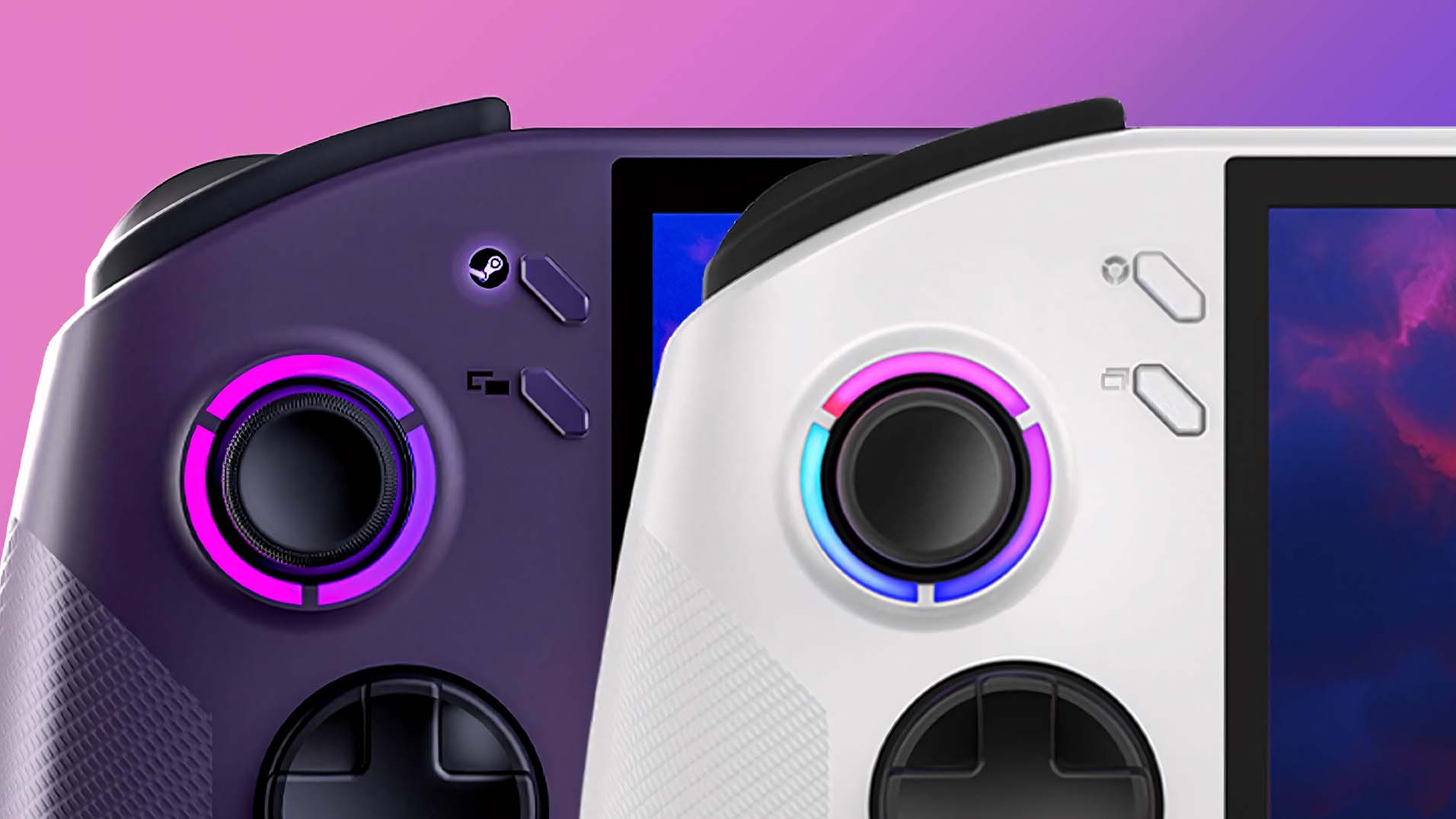
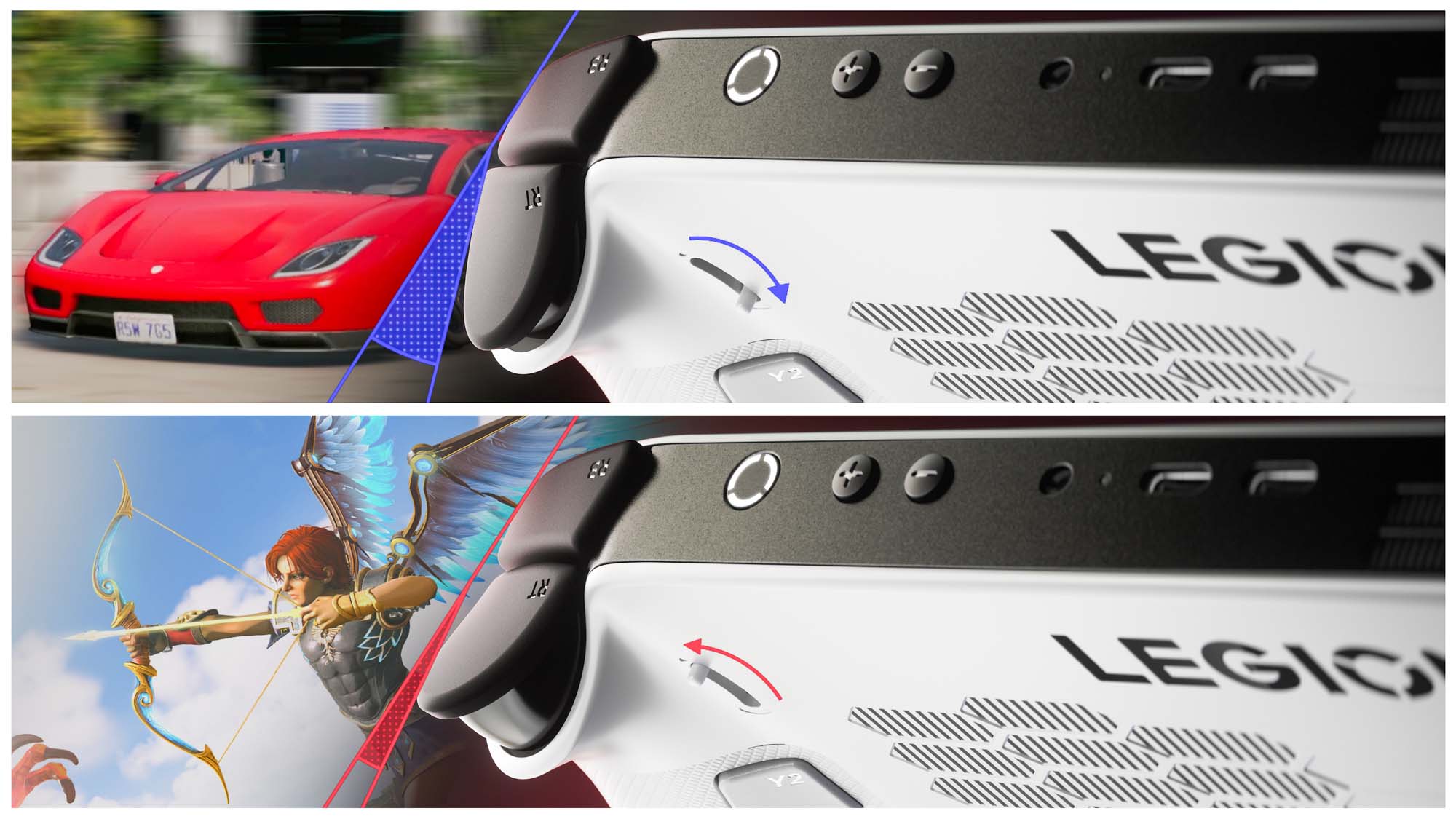
It's also worth noting that there is a difference between the Windows 11 Legion Go S versus the SteamOS handheld. On the Windows 11 version, the top left button brings up Legion Space, but the Steam version has a Steam button instead.
Speaking of the front of the device, both the Legion Go S and Legion Go have ABXY buttons, two Hall Effect joysticks, a D-Pad, bumpers, triggers, Menu buttons, View buttons, and Legion R buttons.
But you'll notice that the D-Pad looks different, and the touchpad has been made a whole lot smaller on the Legion Go S. The smaller touchpad still works well, but might require a bit more swiping in some games.
There are only two buttons on the back of the new Legion Go S compared to four back buttons, two side buttons, and a mouse wheel on the back of the Legion Go.
This reduction is largely due to the Legion Go S not having detachable controllers and, thus, not needing FPS mode buttons (basically a mouse mode).
However, you will notice that the Legion Go S has something on the back that the Legion Go doesn't have — adjustable trigger switches, which can help give players better control during different types of games.
TL;DR: CONTROLS WINNER: Since it has a better layout and provides better trigger controls, the new Legion Go S wins this category.
Is the software experience different on the Go S vs Go?
The Windows 11 Legion Go S version and the original Legion Go (which also runs Windows 11) can access any gaming service or retailer that you would be able to access on a gaming laptop right out of the box.
For instance, you'll be able to use a web browser to access Steam, Epic Games, Battle.net, and more.
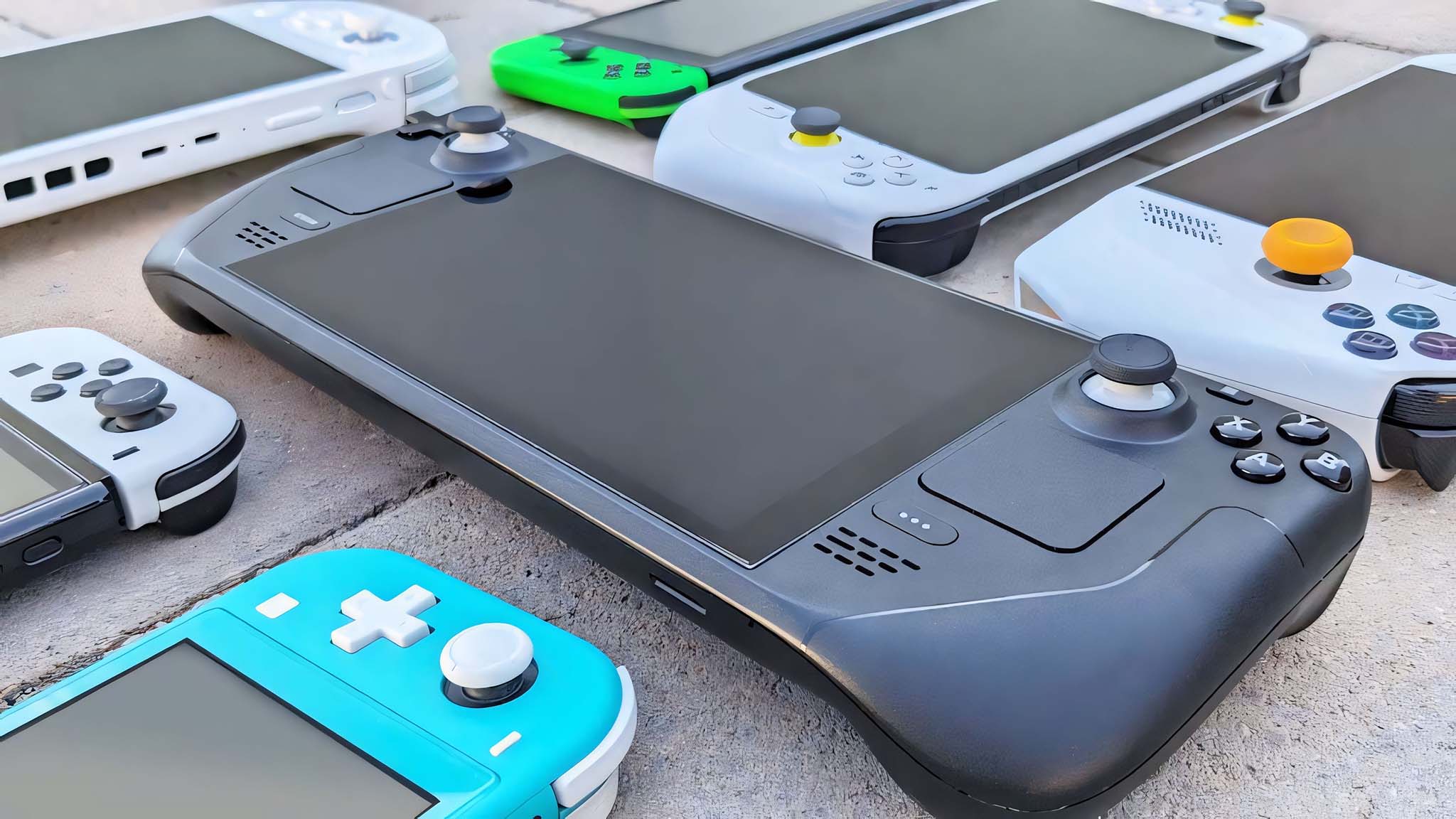
- Best gaming handhelds 2024
- I was wrong about the ROG Ally
- Lenovo Legion Go Review
- Best power banks for ROG Ally
- Steam Deck OLED vs Steam Deck LCD
However, many people will be drawn to the SteamOS Legion Go S since this Linux-based operating system has a simplified interface, which makes the handheld feel more like a game console than a full-blown computer.
Just like with the Steam Deck, SteamOS literally ties to your Steam account, making it quick and easy to access your Steam library of games without having to navigate around the internet.
Anyone familiar with Linux can tell you that it is highly customizable, but it can take some time to get used to it.
If you're more comfortable with Windows 11 and want to do more than just play games on your handheld, then a Windows 11 operating system might be a better fit.
I'm not sure if Legion Space will be on the SteamOS Legion Go S handhelds, but it comes installed on the Windows configurations. This program is far more limited than the software that comes on ROG Ally, but it can still help you adjust system settings.
I do find it really weird that you have to go into the BIOS to adjust VRAM on Legion Go or Legion Go S, though.
TL;DR: SOFTWARE & GAMES WINNER: The Legion Go S wins this category since it offers more options to choose from, whether you want to access any gaming service out of the box with the Windows 11 version or else want a simplified but highly customizable SteamOS interface.
Does the Legion Go S have better battery life?
Based on battery information revealed by Lenovo, I had previously assumed that the Legion Go S would have better battery life than the original Legion Go handheld, but that's not the case.
Despite the original handheld having a 49.2 Whr battery and the Legion Go S's 55.5 Whr battery, the two devices actually tend to last around the same amount of time when playing intensive games — roughly 1.5 hours.
When playing less demanding titles or performing simple tasks, the devices can last between three and four hours.
Of course, it's also possible that having Windows 11 vs SteamOS could impact the device's battery life. But we'll have to wait until the Legion Go S (SteamOS) comes out so we can test these devices ourselves to know for sure.
TL;DR: BATTERY LIFE WINNER: We have a tie. Despite the Legion Go S having a larger battery capacity and a supposedly improved power consumption, it basically reached the same amount of battery life as the original Legion Go in our testing.
Is the Legion Go S more comfortable to hold?
I have pretty average-sized hands, but when I first held the Legion Go, I immediately noticed that the boxy device and controllers were uncomfortably thick. Even my 6-foot-five husband, with his larger-than-average hands, found the handheld a bit too large to hold comfortably.
The original Legion Go measures 11.8 inches wide, 5.15 inches tall, 1.61 inches thick, and it weighs a hefty 1.88 pounds. Meanwhile, the new Legion Go S (Windows 11) is roughly the same height and width but notably lighter and thinner.
The new Legion Go S isn't nearly as boxy as its predecessor, which makes it far more comfortable to hold. It measures 11.77 inches wide, 5.02 inches tall, 0.88 inches thick, and weighs 1.63 pounds.
Lenovo did a good job of balancing the weight of the internals and making a casing that feels great in your hands.
On another note, I personally find it hard to get my thumb to reach the lower two buttons on the original Legion Go's left controller. However, these buttons have found new placement on the Legion Go S, which makes them easier to access and, thus, more comfortable to use.
TL;DR: COMFORT WINNER: Based on the slimmer casing, reduced weight, and more rounded design, the Legion Go S is definitely easier and more comfortable to hold.
How do accessories compare for the Go S and Go?
The Legion Go comes with a hard shell carrying case and an FPS mode stand for the detachable right controller. Additionally, there are a few third-party docking stations, protective cases, skins, and other accessories on the market.
While not an accessory, the fact that it has a built-in kickstand with that larger screen means that it's very easy to pair a keyboard to the Windows 11 handheld and use it like a computer; you don't have to go buy a peripheral with a kickstand if that's a feature you want.
As for the Legion Go S, there might be some pairing differences between the SteamOS version and the Windows 11 version.
There aren't as many accessories specifically made for the Go S's shape and size. However, if the handheld sells well, more third-party options will likely become available over time.
TL;DR: ACCESSORIES WINNER: This win goes to the Legion Go. It comes with a carrying case, while the Go S does not. Additionally, simply by virtue of having been out on the market longer, there are more third-party accessories available for the older device. However, that could change with time.
Legion Go S vs Legion Go side-by-side
Category | Winner |
|---|---|
Price | Legion Go S (SteamOS, Z2 Go) — Starting at $599.99, this upcoming handheld is cheaper than the $699.99 starting price of the Legion Go or the $729.99 starting price of the Legion Go S (Windows 11). |
Performance | Legion Go S Z1 Extreme — The Z1 Extreme is more powerful than the Z2 Go. Combine the chip with more RAM and a screen that supports VRR and you get a much better device. |
Display | Legion Go S — Technically, the original Legion Go has a larger screen, higher resolution, and higher refresh rate. But it doesn't support VRR or native landscape, which help games run more smoothly. |
Controls & ports | Legion Go S — The newer buttons and controls have been improved upon, plus they've been rearranged, which makes them easier to access. Additionally, the new handheld has USB4 ports, which is an improvement over the USB-C ports. However, if you specifically want something you can play in tabletop mode with detached controllers than the Legion Go is a better pick. |
Software & games | Legion Go S — This one will come down to a matter of preference. The Windows 11 Legion Go S can access the same services as the original Legion Go out of the box. However, some people will find the SteamOS configuration easier to use due to its simplified interface. Legion Go S wins in this case because it offers more options than Legion Go. |
Battery life | Tie — The newer handheld and the original tend to last the same amount of time when running more graphically demanding games. |
Grip | Legion Go S — Due to its slimmer design, lighter weight, and rearrangement of buttons, the newer Legion Go S is more comfortable to hold. |
Accessories | Legion Go — This win goes to the original handheld simply because it has been out longer on the market and so there are more accessories for it. |
Best overall | Legion Go S — The new Go S feels better in your hands, has a screen that supports VRR, comes with your choice of Windows or SteamOS. However, the Legion Go is still a great value buy. |
Should you buy the Legion Go S or the original Legion Go?
Alright, we've discussed all of the differences between the Legion Go and the Legion Go S variants, but which one should you actually buy?
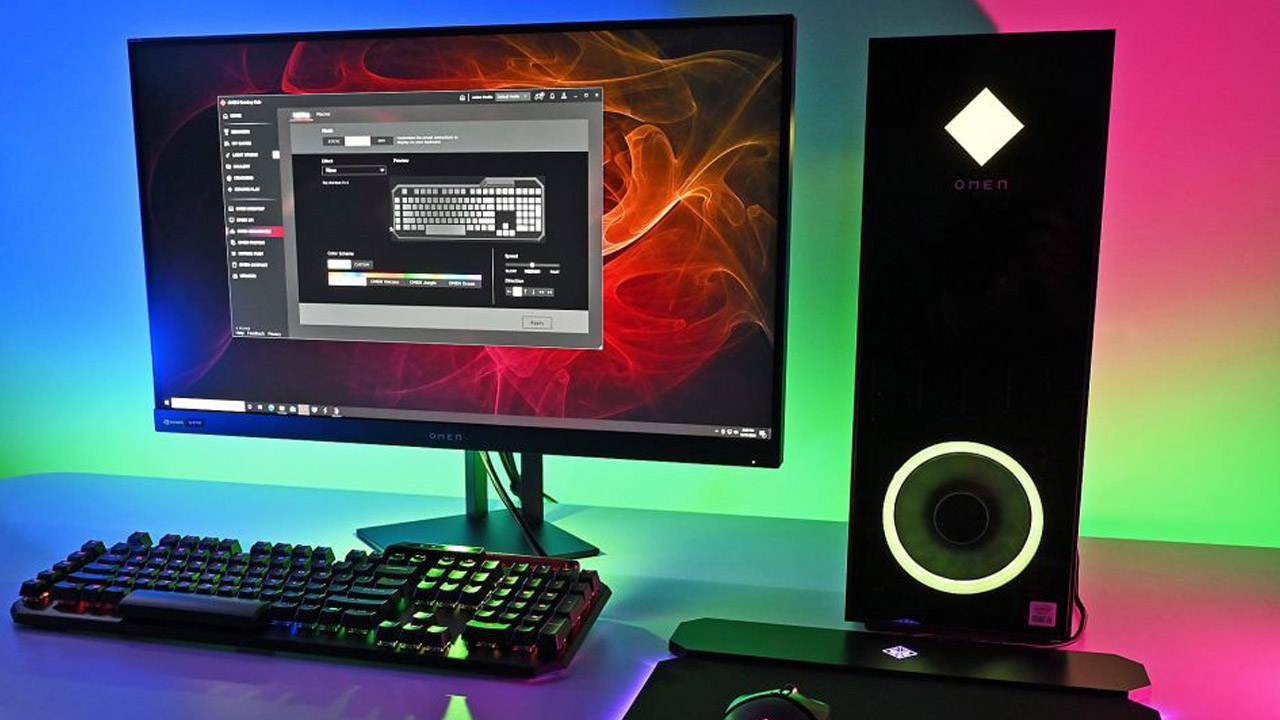
• Best Xbox / PC headsets in 2024
• Best upcoming Xbox / PC games
• Best Xbox controllers
• Best Xbox accessories
• Best small gaming PCs
• Best gaming laptops in 2024
• Best gaming handhelds 2024
In terms of features and performance, the Legion Go S Z1 Extreme configurations are better. These handhelds have much better control layouts, VRR, and far better grip design than the original device.
If you want a simple Steam-Deck-like experience, go with the SteamOS Legion Go S. But if you want a more traditional computer, grab a Windows model. Just do yourself a favor and avoid the Z2 Go options.
That said, the original Legion Go can still be a better value choice for most people, and it offers far more versatility.
It has a larger screen, higher resolution, higher refresh rate, detachable controllers, and a built-in kickstand. As such, it serves as a great computer for anyone who pairs a keyboard with it.
Plus, you can detach the controllers and use the handheld more like a tablet to stream shows if you want.
Consider what features you want most in your handheld, and if you just want a simple gaming device, then go for the Legion Go S. If you want more of an all-rounded gaming and entertainment device, consider the Legion Go.

The original Legion Go is a fantastic choice for people who want a handheld with a larger screen or for people that want to use their device in tabletop mode. This 8.8-inch screen device comes in two configurations with a Z1 Extreme processor, 16GB RAM, and up to 1TB SSD.

Self-professed gaming geek Rebecca Spear is one of Windows Central's editors and reviewers with a focus on gaming handhelds, mini PCs, PC gaming, and laptops. When she isn't checking out the latest games on Xbox Game Pass, PC, ROG Ally, or Steam Deck; she can be found digital drawing with a Wacom tablet. She's written thousands of articles with everything from editorials, reviews, previews, features, previews, and hardware reviews over the last few years. If you need information about anything gaming-related, her articles can help you out. She also loves testing game accessories and any new tech on the market. You can follow her @rrspear on X (formerly Twitter).
You must confirm your public display name before commenting
Please logout and then login again, you will then be prompted to enter your display name.
